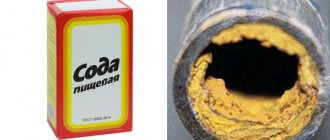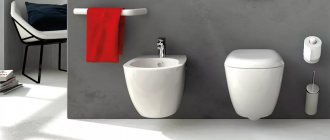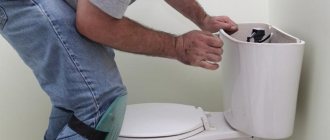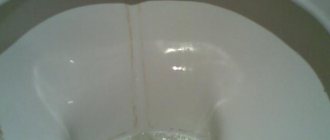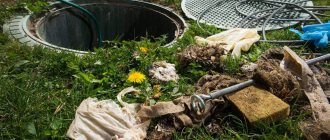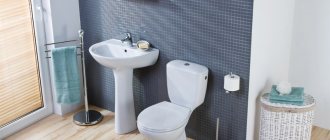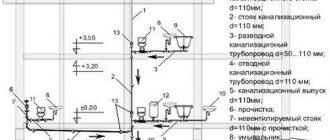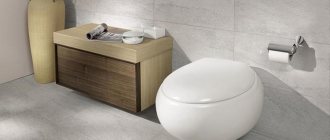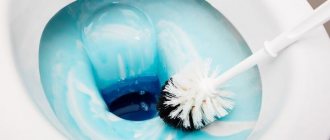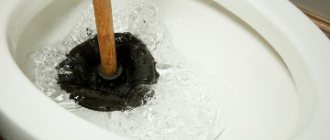Anyone can face the unexpected problem of a stagnant toilet. There is no point in putting off fixing plumbing problems. Let's look at the signs and causes of a clog in the toilet and learn how to remove a clog in the toilet with your own hands.
You can understand that the toilet is faulty by the following signs:
- dirty water does not leave the toilet completely after flushing;
- unpleasant odors appeared in the toilet;
- when flushing, the water fills the toilet bowl approximately halfway;
- The water goes down the drain very slowly.
If at least one of the listed signs is present in your toilet, we can confidently state that it is clogged and the drain needs to be cleaned.
Cleaning a clogged toilet using a plunger
Removing a blockage using a plunger is a mechanical method and is suitable for removing a blockage. If you suspect that a foreign object (child's toy, rag) has gotten into the toilet, it is better to remove it before you start working with the plunger.
You can remove objects by wearing rubber gloves. Otherwise, there is a risk of pushing debris further down the pipe and blocking the sewer system. A plunger is an effective remedy for clogged toilets.
- Before starting work, close all drains (bathtub, sinks).
- Place the plunger into the toilet drain hole. Pour five to six liters of water on top so that the rubber part of the plunger is completely covered.
- Pump the plunger at least ten times up and down. Movements should be sharp, but uniform. If the water goes away, then everything is done correctly.
Fillers and drainage
Types of fillers
The answer to the question whether it is possible to flush wood filler down the toilet depends on the material from which the filler is made. And although manufacturers of virtually all varieties do not recommend using this method of disposal, some substances still tolerate flushing better than others.
The most popular types of cat litter include:
- Woody - made from pressed sawdust, from time to time flavoring impregnations are added to the composition. When liquid gets in, the wood first delaminates and then begins to clump. Among the main advantages of this material are environmental friendliness, relatively low price, ease of disposal, and absence of toxins. Along with this, the material requires regular replacement, otherwise an unpleasant odor will appear within 4 to 5 days after fresh filling is completed.
Note! Experience says that varieties without aromatic impregnation absorb odors optimally. Pine and fruit tree shavings already smell pleasant, and when mixed with cat waste products, they do not form a nauseating “cocktail”, which is often not uncommon with citrus or fruit flavors.
- Mineral - made on the basis of bentonite clay and other substances with high adsorption properties (zeolite, vermiculite). It clumps quite well, which makes it easier to remove the used part of the material using a scoop. The main advantage of clay materials is that they can quickly absorb a lot of liquid, virtually leaving no odor.
- Silica gel is the most modern and practical, and has not displaced other varieties from the market only due to its high cost. Requires replacement every two to three weeks, completely binds all odors. But it should not be used for kittens, because they often chew the granules, which can lead to unpleasant health consequences.
As we noted above, the instructions from the manufacturer of most of these materials recommend disposing of them along with hard household waste. All products of this type are non-toxic, therefore there is no concern about any significant pollution of the external environment.
But many of us try to cut down on labor costs by flushing waste cat litter down the drain. Let's see if it's possible to do this?
Disposal methods
The material from which the filler is made determines its behavior when interacting with liquid. Accordingly, it depends on whether the waste will pass through the pipe or get stuck in it, forming a plug.
You will find the answers to this question in the table:
| Type of filler | Possibility of flushing the toilet |
| Woody |
|
| Mineral |
|
| Silica gel |
|
Summarizing all of the above, it should be noted: you should not create trouble for yourself by washing substances not intended for this purpose down the drain. It is better to collect and throw away the contents of the cat litter, or (in the case of woody and mineral varieties) put it in a compost heap.
Clearing a toilet blockage with a plastic bottle
You can quickly get rid of a clog in the toilet using improvised means. For example, using a regular plastic bottle with the bottom cut off and the cap tightly screwed on.
- The device must be carefully and slowly inserted into the drain.
- As soon as you feel the air pushing the bottle back, push it sharply to the very end of the drain hole. After this, remove the bottle from the drain with a sharp movement.
The water will go away and the congestion will be eliminated if the procedure is repeated two or three times.
Methods for removing blockages
Mechanical pipe punching
If trouble does occur, and as a result of the ingress of a huge amount of filler the sewer system “rises,” measures need to be taken.
You can deal with blockages like this:
- If the incident has just happened, and the bulk of the material is in the toilet itself, it is necessary to remove it from there as quickly as possible. To do this, we put a rubber glove on our hand and scoop out everything we can reach.
Advice! If you don’t have gloves, you can wrap your hand in a plastic bag.
- After manually cleaning the toilet, you need to push the residue (there should be quite a bit of it) into the pipe itself. To do this, install a plunger on the drain hole, press the rubber socket well to the surface and begin pumping, as during simple cleaning.
- To make the work more effective, you need to add a small amount of water to the toilet. But don’t overdo it - if the cork turns out to be very dense, then you will have to remove the water by scooping it out.
- As long as sawdust filler gets into the pipes, a plunger should be enough. But bentonite is capable of blocking the lumen “tightly”, so the plug will need to be destroyed mechanically.
- To do this, we use a cable with a special attachment, which we screw into the jam and destroy it. Our goal is to punch a hole in the center of the pipe, and then the flow of water will slowly wash away the contamination.
Chemical methods
In some cases, the filler does not form a blockage, but simply accumulates in the drain and reduces the throughput capacity of the sewer.
Here it is possible to cope with the situation using chemical means:
- We pour granular powder into the pipes in the most problematic area.
- Add a small amount of water and leave for approximately 20-30 minutes. for reaction.
- Then we carefully rinse the system, draining the water from the tank a couple of times.
- Along with this, acidic agents are considered the most effective, because they are good at destroying organic matter accumulated in the sewer.
Clean the toilet with a solution of baking soda and vinegar
Vinegar and baking soda will help break through simple clogs in the toilet. You should not use this cleaning method if the corrugation (connection of the toilet bowl and pipe) is made of plastic. Hot water with baking soda and vinegar can ruin thin plastic.
Using vinegar and soda, you can quickly and effectively clean the toilet from contaminants such as grease plugs and food waste.
- Take half a packet of baking soda and pour it into the drain hole.
- Prepare one glass of vinegar and pour it into the toilet bowl.
- Wait half an hour and pour 3-5 liters of boiling water into the drain.
So what kind of cat litter can be flushed down the toilet?
In principle, it is possible to wash off wood filler, but it is highly undesirable to do so. You need to wash it off a little, in small portions, each portion no earlier than half an hour later. If you flush it down the toilet, you do so at your own risk, as clogged sewer pipes can cost you more. Wood filler dissolves and can circulate through the sewer system, but if there is wear on the sewer, blockage of joints and bends, which weakens the pressure of the drain, this filler, when dried, creates additional blockage leading to repair and cleaning of the pipes.
The most correct and safest way is to throw it in a solid waste bin and not fall for the marketing tricks of filler manufacturers.
How to break through a blockage with a cable
Using a special sewer cable will help you quickly and efficiently get rid of the blockage. It is better to do the work together.
Prepare unnecessary rags, oilcloth, a bucket or basin with water and dishwashing detergent.
- Roll out the oilcloth on the floor and cover the walls.
- Place the end of the cable into the drain hole and slowly move it down using a rotating motion.
- Once the cable has stopped and won’t go any further, move it back and forth.
- Remove the cable by lowering it onto the oilcloth. Clean with a cloth soaked in dishwashing liquid to remove unpleasant odors.
What to do if the toilet is clogged with cat litter
If this problem happens and your toilet is clogged with cat litter, you can try to break through the blockage with a plunger or a plastic bottle, especially if the blockage is located nearby and not much.
Please note that toilet plungers are different from sink plungers.
If it was not possible to clean it in this way, a plumbing cable will come to the rescue, which eliminates most problems with clogged sewer pipes. A very convenient thing, it rolls up into a coil and does not require much storage space.
Video: How cat litter swells
Hydraulic method
Hydraulic cleaning method
The method is suitable for removing “plugs” that have formed deeply and allow water to pass through, that is, for loose blockages. Typically used when organic debris and small particles accumulate. Operating principle:
- the hose is pulled from the water tap to the toilet and inserted into the sewer drain;
- Next, turn on the hot water;
- The blockage is washed away by adjusting the water pressure in the hose.
But this method should be excluded if the pipe is so clogged that the plumbing equipment is filled with water.
Using a plunger and cable for mechanical cleaning
Plunger and cable
The simplest and most popular tool for removing blockages that form in any plumbing equipment is a plunger. It must be installed in the equipment with the bowl down over the drain hole so that the rubber is completely immersed in water without forming an air cushion. Then you should make a sharp movement, pressing on the handle of the tool and loosening the press. Repeat several times. The essence of the method is the formation of a hydraulic shock that destroys the plug.
A special cable is used if the plunger turns out to be useless and the blockage is far away in the pipe. It is better to use the services of an assistant. For example, he will twist the handle of the cable, and you will push the cable through the pipe. You can clean the water seal using this method in a matter of minutes.
As a last resort, you can use a special hook to clear stubborn clogs, which is the best way to remove a toy or rag that has clogged the drain pipe. This work must be done with gloves.
Causes of blockage
Let's look at the main reasons for the formation of traffic jams:
- Violation of the rules for using sewerage. For example, throwing scraps into the toilet, getting into the system rags, large amounts of paper, toys and other debris that does not dissolve in water.
- Violation of the rules and requirements for the installation of plumbing: incorrectly selected angle of inclination of the pipe going to the riser (2 cm per 1 linear meter); failure to maintain the distance between objects (at least 1 meter).
- The system does not have a valve or a free-flow pipe (fan pipe), which negatively affects the pressure when draining water. It does not pass quickly, as a result of which high-quality flushing does not occur.
- Incorrectly selected elements of plumbing equipment. The market offers customers a huge range of products, which, unfortunately, do not always have high-quality assembly. Such devices are subject to various breakdowns, blockages and very quickly become unusable.
Prevention of traffic jams in the sewer system
Prevention measures
A few tips regarding their use will help you avoid troubles associated with cleaning the toilet.
- Use plumbing equipment as intended.
- Pay attention to the speed of water drainage, this indicates the functionality of the vent riser.
- Clean the water seal periodically using chemicals.
- Monitor the operation of the riser.
It is better to carry out a series of preventive works to clean the sewer system in a timely manner than to wait for a dense blockage to form, which causes a lot of problems.
Solutions
When they talk about removing a blockage in a toilet, they mean removing the resulting blockage in the water seal system. But often the collector pipes or sewer riser are clogged with debris, and not the water seal itself. Most often, a problem arises with the riser and it is this part of the sewer system that requires cleaning or replacement if it is old and cast iron. You can clear the clog in different ways.
- Remove accumulation of debris (“clog”).
- Move the “plug” further through the system.
- Using a chemical to dissolve the debris.

